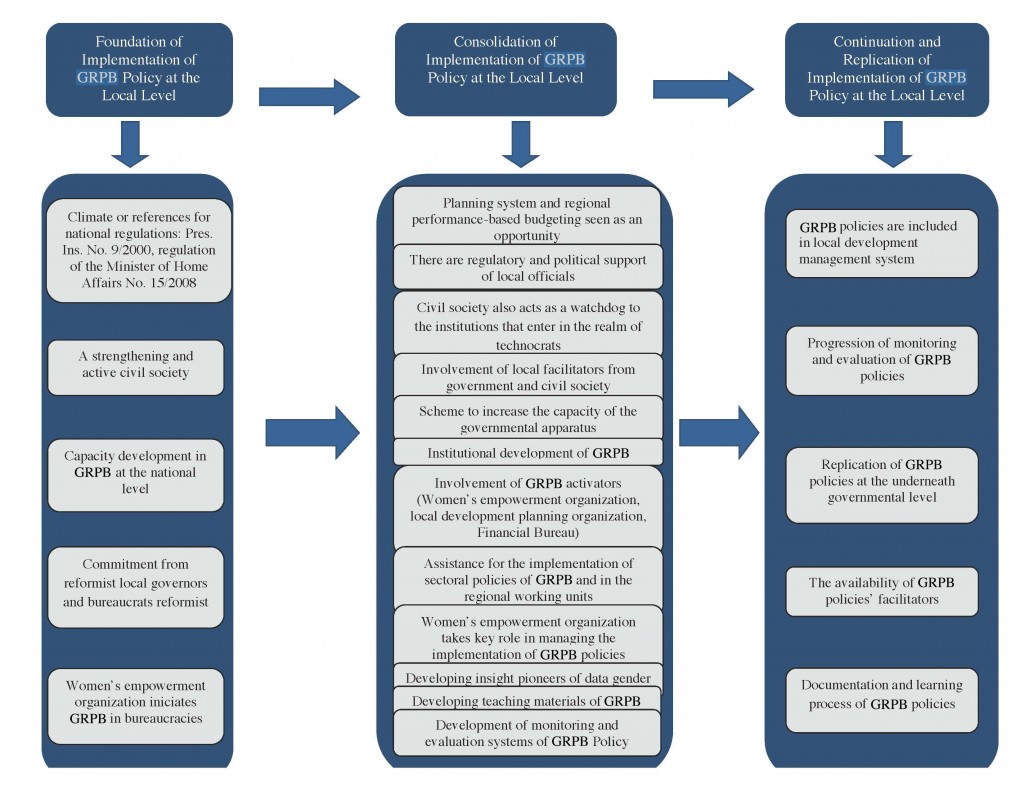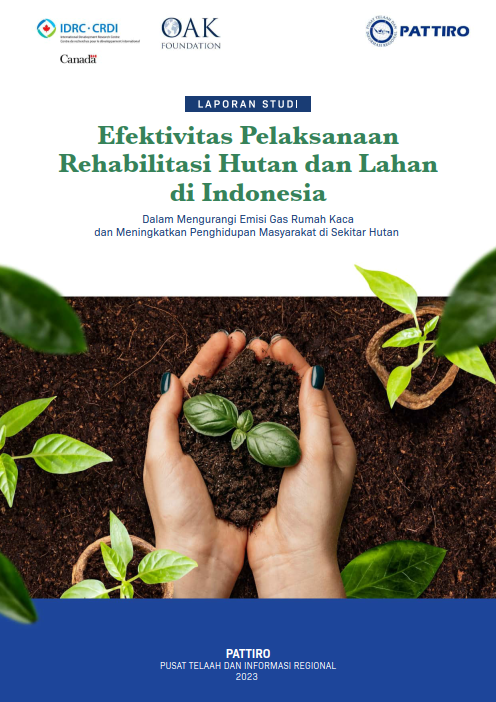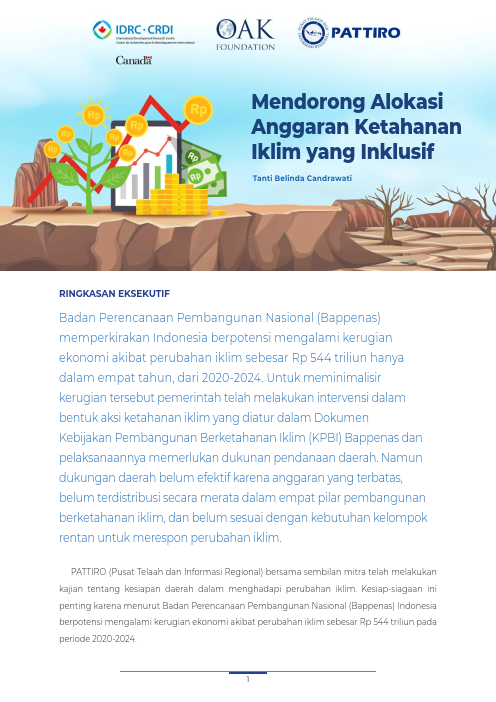 I. INTRODUCTION
I. INTRODUCTION
In the last few years, the application of a gender-responsive planning and budgeting (GRPB) policy has strengthened the implementation of a gender mainstreaming strategy in development at the local level. There is a variation of progress between local regions in the implementation of GRPB policy to support gender equality and fairness.
Experiences of the implementation of the GRPB policy in Central Java Province, Special Region of Yogyakarta (DIY) Province, West Sulawesi Province and other local regions have been extracted in this Policy Brief Series-2. This Experience Extracts from the Implementation of GRPB Policy at the Local Level document is a secondary source and a reinforcer of the argument for the submission of options for the change of GRPB policy in local areas as was contained in Policy Brief Series-1: Policy Options for Accelerating the Implementation of GRPB at the Local Level.
II. GRPB POLICY PHASES AT THE LOCAL LEVEL
The process of implementing GRPB policy at the local level can generally be divided into three key phases, those are:
- Foundation Stage. This phase provides the references and regulations for the implementation of GRPB policy at the local level, such as Presidential Instruction No. 9, 2000, Ministry of Home Affairs Regulation No. 15, 2008, and Presidential Regulation No. 8, 2008 on the Procedural Stages of the Preparation, Control and Evaluation of the Implementation of a Regional Development Plan. Through this regulation at the national level, the Ministry for the Empowerment of Women and Child Protection has been mandated with acting to increase the capacity of GRPB policy implementers at the provincial level. The provision of guides and guidelines of a generic nature is one model for capacity building. Facilitation or training undertaken by the Ministry for the Empowerment of Women and Child Protection at the provincial level with the engagement of stakeholders is a good start for arranging the implementation of GRPB policy. A portion of participants – although a limited number – have the ability to become facilitators and undertake advocacy together with drivers of GRPB drivers at the local level, both those from the Gender Mainstreaming Working Group and the focal points of regional working groups (SKPD). This process of capacity building at the provincial level has given birth to individuals from the bureaucracy that understand the value of gender for accountability in development, with a tendency to be reformist, open and possess a fighting spirit. This is a model for GRPB policy advocacy going forward. The implementation of GRPB policy will succeed if the agencies/bureaus for the empowerment of women also possess a fighting spirit and understand their work, basis and function as facilitator and advocator. They need to initiate, with the assets that they possess, the development of a structure for the implementation of GRPB.
- Consolidation Stage. After laying the foundation, the implementation of GRPB policy enters a process of consolidation of the structures that have already been put in place and adapted to the specific/contextual needs of each local region. Capital at this stage shapes the opportunities that become commitments at the national and local levels regarding a performance-based planning and budgeting system that is usually the priority of local leadership and set as regulation. Following the building of stakeholder capacity GRPB drivers at the local level prepare plans for building the capacity of their partners, as needed. The keywords ‘as needed’ must be noted, as the needs of each local area are different. In this phase, the government begins to engage with civil society, which previously possessed a path outside the technocratic process of local budgeting and planning, and at the same time provides space for the enriching of GRPB policy implementation. Non-Government Organisations (NGO) have a role in filling the empty spaces related to fundamental issues, such as the availability of disaggregated data, analysis of gender-responsive sectoral issues, and mentoring of the sector. Before that, the role of the facilitator was only undertaken by government agencies, such as the Gender Mainstreaming Working Group, focal points or GRPB Technical Team. The Local Development Agencies (Bappeda) and SKPD that oversee the task of empowering women are the main drivers of GRPB policy at the local level. Together, they need to improve institutional development related to the function GRPB in accordance with the development cycle. Within this, they engage the Inspectorate, Bureau of Finance, SKPD and civil society. This institutional development includes an area from the driver function for the facilitation and advocacy of GRPB policy. For example, facilitating sectoral needs for the analysis of gender appropriate to the individual sector and undertaking mentoring of it. Other than that, there needs to be a strengthening of prerequisites that are yet to be fulfilled for the development of eye-opening data, teaching materials, and a GRPB policy evaluation and monitoring system.
- Sustainability and Replication Stage. The process of sustaining is one thing that is important in the implementation of GRPB policy at the local level. Maintaining the sustainability of GRPB policy is achieved with its integration into the local development management system, from planning, budgeting, implementation, monitoring and oversight, through to evaluation. Replication is one indicator of the sustainability of GRPB policy implementation. After the process of GRPB policy implementation has occurred at the provincial level, drivers of GRPB can advocate at the kabupaten (district)/city level. They facilitate the same processes appropriate to the previous stage. Documentation of work that has already been undertaken in the implementation of GRPB policy at the local level is important for monitoring the implementation and at the same time, supporting attempts at replication. This documentation can become a reference for attempts at the implementation of GRPB policy.
The three key stages of GRPB policy implementation at the local level are illustrated in the schematic below:
III. KEY FACTORS FOR ACCELERATING THE IMPLEMENTATION OF GRPB POLICY AT THE LOCAL LEVEL
In implementing GRPB policy at the local level, we can identify three key factors for its acceleration, they are:
1. Synergising political commitment, technocratic capacity in the bureaucracy, and the role of civil society
Political commitment is one variable that is strongly influential in the acceleration of the implementation of GRPB, as allows for the consolidation of resources, as well as political and financial support. This political commitment, however, needs technocratic capacity support at the bureaucratic level and the involvement of civil society. Simply having political commitment will stop the process on paper, as was the experience with South Sulawesi’s implementation of GRPB policy. Bureaucratic support and capacity is needed to raise the gender perspective in operational and technical planning and budgeting documents, that is, in SKPD Work Plans (Renja) and SKPD Budget Work Plans (RKA-SKPD). Civil society has a role in accelerating GRPB policy with government performance monitoring and becoming a critical partner for government. Civil society’s role as a control requires government to work well and accountably. At the same time, the role of critical partners complements the internal capacity of government so that it is sufficient to meet the demands of the public.
Local experience demonstrates that the successful implementation of GRPB policy is influenced political and social support-raising by the SKPD that oversee the work of women’s empowerment. Because of that, the SKPD that oversee this, must have clear authority, possess an HR and financial capacity that is satisfactory in the propagating of the idea of GRPB policy to other SKPD and government agencies, as well as ensuring the existence of GRPB institutions that work effectively at the local level.
In various local areas, the capacity and roles of the SKPD that oversee the empowerment of women are not yet strong. This results in the implementation of GRPB policy failing, because it has not become a cross-sector movement with cross-sectoral awareness. In a context like this, it will be strategic if national GRPB movers strengthen the capacity of SKPD that oversee the empowerment of women at the same time as other driver organisations (Bappeda, Bureau of Finance and Inspectorate). This strengthening also needs to take into account the governmental level with a consideration of the dualism of the provincial position – as representative of the central government at the local level and as an autonomous authority. Other factors that need to be taken into account are the position as well as management complexities at the district/city level. The success of building support by GRPB drivers explains the advances of GRPB policy implementation in various local areas.
3. Performance-Based Planning and Budgeting Accelerates the Implementation of GRPB Policy
The implementation of a performance-based management system in the development of local areas develops important momentum for the implementation of GRPB policy. When compared with a traditional budgeting system, the application of performance-based management brings with it opportunities, because it allows for the insertion of the issue of gender into formulation and development targets for key performance indicators. This opportunity, also, encompasses the whole management cycle, from planning through to evaluation. Performance-based planning and budgeting allows for the evaluating of how development programs correlate with the reduction of the gender gap in various sectors and the improvement of public services that are fair for men and women.
4. CONCLUSIONS
Success in the accelerating of GRPB policy implementation at the local level is greatly dependent on three key factors, they are:
- The synergizing of political commitment, technocratic capacity in the bureaucracy, and civil society
- Strong capacity in the SKPD that oversee the task of empowering women and GRPB institutions at the local level
- Performance-based planning and budgeting accelerating the implementation of GRPB policy
To download this policy brief in pdf version, click this link below:





